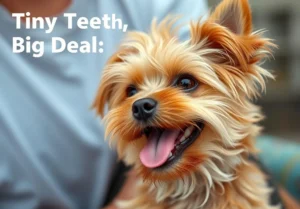Disclosure: We may earn a commission from helpful, relevant links in our content. No cost to you. See our privacy policy.
Many dogs have naturally white teeth but don’t always remain white. So what makes them white in the first place compared to us?
Humans, unlike dogs, consume sugar-rich foods leading to dental problems. Sugar intensifies bacteria in our mouths. However, dogs aren’t typically exposed to our main teeth-staining culprits: tea, coffee, soda, and juices, which often contain a lot of sugars, as well.
Additionally, dogs have an alkaline mouth environment compared to humans. This pH difference makes their teeth less susceptible to decay caused by acid-producing bacteria.
Furthermore, dogs’ teeth have a protective layer of enamel (thin layer covering a tooth) just like ours, but their enamel is even more robust, ensuring they remain white and strong, especially in their early years.

Are Dogs Supposed to Have White Teeth?
For the first 2-3 years, dogs’ teeth are white. They will naturally yellow over time. It’s one of the methods veterinarians use to determine a dog’s age. But since dogs don’t consume coffee or coke, their teeth are generally white and get yellower with age.
Consider that many dog breeds and their lupine predecessors use their teeth for hunting, fighting, and feeding, so having sturdy teeth that outlast the rest of the dog is advantageous. They are vital to survival, so they must be more robust than ours in terms of longevity.
On the other hand, humans have superior ways of protecting themselves and obtaining food, and we may devise solutions to the feeding problem. Our teeth aren’t nearly as important and, as a result, are significantly weaker compared to a lifetime.
Interestingly, the enzymes in a dog’s saliva are specifically designed to combat the types of bacteria that lead to dental diseases, further supporting the natural whitening process.
Unless properly maintained, a dog’s teeth turn brown and wear down over time. They will wear down no matter what. Dogs’ natural food contains ingredients that naturally clean teeth, but keep in mind that dogs don’t live as long as humans do, so they don’t require their teeth to be healthy for decades as we do.
Should You Brush Your Dog’s Teeth?
Dogs need their teeth cleaned regularly, but most people don’t think about brushing or doing it.
Brushing their teeth is the best option. In as little as 3-5 days, plaque hardens into calculus, a specific mixture you can’t brush off. Even if you can commit to brushing your dog every other day, it will help them significantly.
Dogs require extensive dental care. Brush their teeth regularly, and your vet should examine and assist you in keeping them clean. Unfortunately, many pets (particularly cats) acquire severe dental problems if they live long enough.
I attempt to brush my dog’s teeth three times every week. I also offer her chews like benebones and nylabones, the occasional beef trachea, bully stick, and so on.
Brushing is the most straightforward approach to maintaining good oral health. No matter the routine you choose, the benefits will take time. It will need a consistent dental routine to notice results.
With significant accumulation, dental calculus will irritate the gum tissue, resulting in gingivitis, gumline recession away from the tooth, and tooth loss. This injury can also spread bacteria throughout the body and may impair the heart, kidneys, or liver.
Dogs’ gums provide insight into their dental health just like their teeth. Pink, firm gums are a good sign, but any redness or swelling should be a cause for concern.
You can train most pets to tolerate routine brushing quite readily, and numerous products are available to help you get the job done. To brush the teeth, you can use children’s soft brushes, pet-designed brushes, finger brushes, and even a washcloth soaked in the paste.

If you find a paste flavor they appreciate, they will begin to enjoy the process. One of my dogs adores the poultry-flavored paste and looks forward to brushing their teeth.
If they like to tug, put some toothpaste on a rope. As a treat, feed them a bit on your finger while making ridiculous noises and praising the moon. If your dog does not appreciate the action, finger brushes are a fantastic way to get bit.
To get started with brushing, follow our guide on choosing the right toothbrush for your dog. We have laid out the types, what to look for, so you’ll know which toothbrush is the perfect for your pup.
Can Dogs Use Human Toothpaste?
Human toothpaste includes compounds that, if consumed by our pets, can cause stomach trouble. If the toothpaste has Xylitol and Flouride, these two ingredients are hazardous for dogs. Dogs should not swallow it since they cannot spit out toothpaste.
Compounds such as Xylitol might kill your dog. If your dog swallows this, your dog must receive immediate medical attention. You may not notice any poisoning symptoms until the dog is in liver failure.
I recommend using a canine-specific enzymatic toothpaste, which is easy to find (here’s a good one from Amazon). Check with your veterinarian, pet supply store, or even Walmart.
In all honesty, toothpaste is not that important. It’s not like human toothpaste actually benefits our teeth. Animal toothpaste is simply a nice treat that the pet receives for brushing. The act of brushing is what is most beneficial to your dog.
So please don’t be too concerned about the toothpaste you use, and don’t splurge on an expensive one because it’s unneeded. However, try to pick a brand with a strong reputation among veterinarians, such as Virbac CET or Petsmile. Get one approved by the VOHC.
Or better yet, visit our guide on choosing your dog’s toothpaste. We’ve broken it down what to look for and what to avoid in the case of ingredients, and provided some extra tips for everyone.
If your dog ingests any human toothpaste, keep an eye out for vomiting, diarrhea, lethargy, and whether she’s eating/drinking and eliminating correctly.
How to Clean Dog Teeth Without Brushing?
Calculus can cause problems and can’t be easily removed. Professional dental cleaning would be a good idea before attempting to adopt all of these at-home treatments if there is already a significant quantity of calculus and not only plaque.
You cannot remove the hardened calculus without the specialized techniques used in veterinary practices, no matter how hard you try. Please first consult with your veterinarian to see if this is essential.
Greenies dental chews are an option. My dogs adore them. You can also use carrots to remove plaque. Once or twice a week is a plenty.
Using water additives designed for canine dental health can be an effortless way to supplement the brushing routine. Just add to their water bowl, and these additives work to reduce plaque and freshen breath.
Another possibility is dental toys. We have a blog post with the top picks we tested on our dogs. My dogs preferred the Nylabone brand. They have the shape of dinosaurs, but there are wide varieties.
There isn’t much you can do to prevent plaque and tartar accumulation on dog’s teeth other than brushing. If the vet advised it, I’d pay to get his teeth professionally cleaned to minimize tooth rot and periodontal disease.
Daily brushing with an enzymatic toothpaste and the occasional raw bone do wonders for keeping those pearly whites pearly white in the future.
What Foods Keep Your Dog’s Teeth White?
One method is to eat naturally. Our dog’s teeth developed terrible plaque buildup from a cereal dog food diet. I obtained her kneecaps from the butcher, which she enjoys, and the natural gnawing removed all of the plaque.
Natural bone-eating is a stimulating activity for a dog and helps with tooth cleaning. That is why raw chicken portions are advised for dogs on raw food diets. Raw chicken bones break safely, but you shouldn’t feed your dog with cooked chicken because the bones splinter.
While dry kibble is often mentioned as good for your dog’s teeth, it’s not particularly true, though it can’t hurt. Kibble isn’t bad, but it is also no better than chips or milk bones that dogs love so much. It’s just slightly better for the teeth than wet food.
Some veterinarians recommend occasional raw carrots or apple slices as a natural treat. They’re crunchy, low in calories, and can aid in the natural abrasion cleaning process of your dog’s teeth.
Getting your dog some daily chews, specifically created to bring down plaque and keep your pup entertainined are a much better option.
FAQs
What color should dog’s gums be?
Healthy gums are salmon pink or light bubble gum pink in tone. Because of the completely natural black pigment in the mucus membrane, some dogs have genetically blackish gums. Consider consulting your veterinarian if you notice something like a raised puffy region or anything suspicious.
Can I brush my dog’s teeth with baking soda?
Brushing your dog’s teeth with baking soda is not generally advised. Baking soda can cause stomach upsets, plus most dogs hate baking soda. Dogs need to be rewarded for brushing, so toothpaste should have a nice flavor, such as chicken flavor.
Do dogs’ teeth fall out?
Dogs’ baby teeth fall off naturally, typically for puppies aged 4-5 months. It is not normal for a dog’s teeth to fall out as they age, but it does occur when they have a disease. My aging dog has lost several front teeth due to rough play, yet it doesn’t affect him. The gums are healthy, and I continue to brush him every night.
Alex, a passionate animal lover, has experience in training and understanding animal behavior. As a proud pet parent to two dogs and three cats, he founded AnimalReport.net to share insights from animal experts and expand his knowledge of the animal kingdom.




